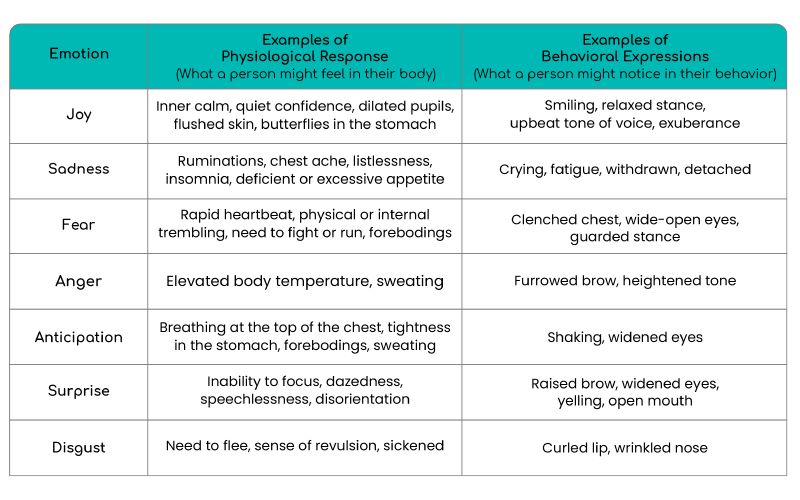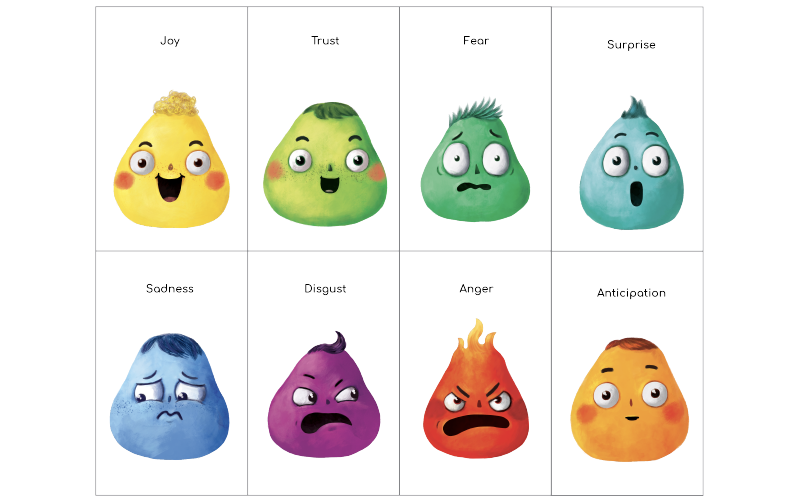What’s the Commotion About Emotions?
Imagine the good feeling of being tucked nicely into your bed. Your 5:15 am alarm sounds, and just before you hit the 15-minute snooze, you hear the tapping of rain on your window. For a moment, you feel a bit of “yuck” about how the storm will affect your commute, and then you feel comforted and happy when you remember that you get to stop by the local coffee shop for your favorite coffee before you start your day. Later, as you are dressing for work, you begin to think about an upcoming social mixer that you really wanted to attend but can’t because the tickets are just too expensive, and you feel sad all over again.
As you’re putting on your shoes, you open an email from your sibling, who you’d let use your credit card to make a $120 purchase, and you are shocked to see they actually made a $750 purchase.
Thinking you’ll deal with that situation later, you get out the door a little early, because you expect the rain will increase the time it takes to get to work, but to your pleasant surprise, there’s no change in the traffic flow. With a little extra time on your hands, you stop at your favorite coffee shop, but the service is so slow that now you’re late. You start to feel frustrated and rushed and think to yourself, “This place is always slow…why did I stop here?” Finally, you get your coffee. Prior to putting the lid on, you see a long strand of hair floating on the top. Now not only are you revolted, but you’re also a bit enraged, feeling like this coffee shop can never live up to its overpriced expectations!
You get another coffee and realize it is now 8:15 am. Knowing the drive to work will take 25 minutes, you feel a bit of a head rush because you have to be at work at 8:30 am. You call a work colleague, explain your situation, and ask them to take care of a work task for 10 minutes. Just like you believed they would, they agree to take care of it until you get there.
In only two hours, during a regular morning routine, you’ve experienced eight different emotions.
What Are Emotions?
Emotions are brain-based, subjective, and conscious states of being that are the combination of four key elements (Barrett et. al., 2007):
1. A subjective experience is the result of the emotional and cognitive impact that an experience has on a person, specific to them. Comparatively, an objective experience is something tangible that can be experienced by everyone.
2. An appraisal of the subjective experience encompasses the unconscious and conscious processes of the subjective experience. Factors that inform our appraisal of the experience include our prior experiences and beliefs that we hold about others in the experience. Our background, culture, and historical and contemporary cultural phenomena influence our experiences, as well.
3. Physiological arousal is the physical changes that we feel in our bodies.
4. Behavioral expression of emotions includes facial, bodily, or verbal expression.
How Are Emotions Different From Feelings?
Emotions and feelings are closely related. Emotions are a brain-based state of being resulting from a subjective experience, an appraisal of that subjective experience, a physiological response, and a behavioral or expressive response (Hockenbury & Hockenbury, 2010). Feelings are sparked by emotions and colored by personal experiences, beliefs, memories, and thoughts linked to that emotion. This ties into our own emotional “appraisal of the subjective experience,” where our background, culture and other personal or worldly influences are factored into our response. A feeling is the side product of your brain perceiving an emotion and assigning a certain meaning to it. It is the physiological response and an expression of that emotion.
While it is essential to know that emotions arise out of subjective experiences, it is equally necessary for students to learn and understand that other perspectives exist. This learning empowers people to be able to see from different viewpoints and supports the development of skills for managing emotions.
Learning to Recognize and Manage Emotions
Social and emotional learning is about two deeply intertwined yet different sets of skills: social competence as well as emotional competence. When we speak of social competence, we focus primarily on an individual’s relationship with others. When we speak of emotional competence, we focus mainly on the individual’s relationship with themselves, and more specifically, their recognition and management of eight basic emotions (Plutchick, 2001, 1984).
Two Considerations About Emotions
Emotions represent a range of feelings
Each one of the emotions represents a category under which we experience a wide range of comfortable and uncomfortable feelings. Our ability to identify and express these emotions and feelings has a profound effect on the degree of satisfaction we experience as we navigate through our life. It influences the relationship we have with ourselves as well as how we solve problems and engage with others. Thus, learning to regularly identify, name, and manage emotions and feelings is critical to our success in learning, play, work, life, and relationships.
Emotions vary in intensity
There are varying intensities for each emotion. For example, the less intense version of joy is serenity, and the more intense version of joy is ecstasy. Using these eight emotions (and their lesser and more intense versions) is a powerful framework for helping students name and recognize their emotions, enabling them to develop a vocabulary that articulates what they feel.

Three Emotion Management Strategies to
Teach Students
1. Teach a developmentally appropriate vocabulary for emotion recognition. Choose fewer words for younger children, such as joy, anger, sadness, and fear; focus on intensity and words that describe the feelings. As students progress developmentally, introduce blends of emotions that produce more complex feelings.
2. Help students develop emotion regulation strategies. Emotional expressions of intense and uncomfortable emotions may appear to be automatic. We may feel powerless about regulating our reactions. Over time and with intentional practice, we can learn to notice the feelings in our bodies and use body-calming techniques to guide our reactions and expressions. Examples of body-calming techniques include using our breath, grounding ourselves through body scan, and staying in the moment through visualization.
3. Use art as a coping mechanism. Art in any form—movement, words, painting, drawing, and music—is a fantastic way to build our skill and capacity to calm and manage our emotions. Something as simple as doodling in the moment can be a non-disruptive way of reducing stress and anxiety about what is going on around you.
As we become more aware of how our emotions may impact our day-to-day life, we are better able to navigate both the positive and challenging moments in and out of the classroom. When we truly listen to how we’re feeling, our emotions can serve as a reminder of our deepest wants, hopes, goals, and desires. With the ability to recognize, name, and manage our emotions, we—both students and educators—will understand how to put language to our thoughts, feelings, and emotions, and use this information to respond in a productive and positive way.
References
Barrett, L. F., Mesquita, B., Ochsner, K. N., & Gross, J. J. (2007). The experience of emotion. Annual Review of Psychology, 58, 373-403. doi: 10.1146/annurev.psych.58.110405.085709
Hockenbury, D. H., & Hockenbury, S. E. (2010). Discovering psychology. Macmillan.
Plutchik, R. (1984). In search of the basic emotions. PsycCRITIQUES, 29(6) 511-513. doi:10.1037/022979
Plutchik, R. (2001). The nature of emotions: Human emotions have deep evolutionary roots, a fact that may explain their complexity and provide tools for clinical practice. American Scientist, 89(4), 344-350.
Please Sign in to Your Account.
Create a Free Account
Gain access to limited free articles, news alerts, select newsletters, podcasts and some daily games.









